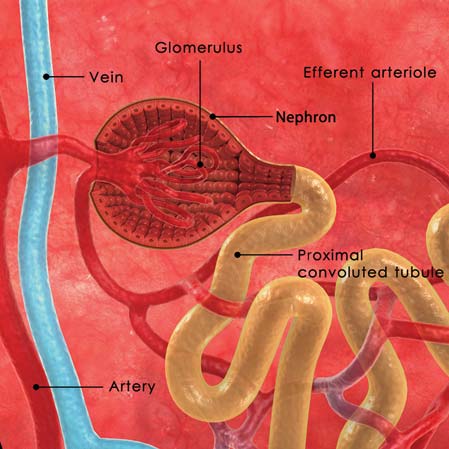Exerpt: From the Gold Cross Magazine CEU Article "Chronic Kidney Disease: A "Quiet Epidemic"
By, Sylvie Mulvaney
By, Sylvie Mulvaney
Download the entire article "Chronic Kidney Disease" a "Quiet Epidemic"
|
Kidney Disease
The renal system is the primary regulator of the body’s internal environment, and therefore essential for life. Without adequate renal function, the body cannot maintain a stable internal environment, and all of its systems are adversely affected. Although the human body can function well with only one kidney, most people have two. The kidneys are two bean-shaped organs, each about the size of a fist, located just below the posterior rib cage, one on each side of the spine. Each kidney contains approximately one million blood filters called nephrons, which purify blood and remove waste products 24 hours a day. Each nephron includes a filter, called the glomerulus, and a tubule. The glomerulus lets fluid and waste products pass through it, but prevents blood cells and large molecules, mostly proteins, from passing. The filtered fluid then passes through the tubule, which sends minerals back to the bloodstream and removes wastes. The nephrons filter about 200 quarts of fluid daily – enough to fill a large bathtub – reabsorbing all but approximately two liters of toxins, waste and excess fluid, which leave the body as urine. Urine flows from each kidney through a thin muscular tube called a ureter, and empties into the bladder.
Through this filtering process, the kidneys help control blood pressure and make hormones the body needs to stay healthy, such as the one that stimulates bone marrow production of red blood cells. In addition, the kidneys help maintain a stable balance of body chemicals, such as sodium, potassium, calcium and acid content.
The glomerular filtration rate (GFR) test is most often used to check how well the kidneys are functioning. It estimates how much blood passes through the glomeruli each minute. Physicians calculate it from the results of a blood creatinine test – which measures how well the kidneys filter creatinine, a chemical waste molecule – and factoring age, body size and gender. A low GFR signifies the kidneys are not working as well as they should. As kidney disease worsens, the GFR number decreases. |
Stages of Chronic Kidney Disease
One kidney working at 20 percent capacity – or with as nephrons – can keep a person healthy. Below that, toxins begin to accumulate, causing fluid collection or overload, tissue swelling, lung congestion and high blood pressure. The body begins to feel tired and weak. At this point, dialysis or transplantation is needed to sustain life. Kidney disease is divided into five stages: Stage 1 – Kidney function is normal, but there is evidence of kidney disease, such as proteinuria, or an abnormal amount of protein in the urine, or hematuria, blood in the urine. Hematuria can be visible or microscopic. Patients are asymptomatic. Stage 2 – Mildly decreased kidney function is noted, with proteinuria or hematuria, for example. Patients are asymptomatic. Stage 3 – Moderate decrease in kidney function is noted. A person in Stage 3 CKD is more likely to develop complications such as hypertension, heart disease, anemia or early bone disease. Some of the following symptoms can begin:
Stage 4 – Due to severely reduced kidney function, waste products build up in the body, and can become toxic if they reach high levels. This is called uremia. Patients in Stage 4 CKD often progress totage 5 before long, and can experience any of the above symptoms, as well as:
Stage 5 – End-stage renal disease occurs when the kidneys can no longer adequately filter waste products and fluid from the body. The kidneys’ other functions, such as blood pressure regulation, production of the hormone that helps make red blood cells and activation of vitamin D for healthy bones also are compromised. Dialysis or transplant is required to keep the person alive. Some symptoms during Stage 5 kidney disease include those mentioned above and:
Although so far we’ve discussed chronic kidney disease and failure, acute renal failure (ARF) is also possible. ARF is the sudden deterioration of renal function, resulting in the accumulation of uremic toxins in the blood, or azotemia. It can develop suddenly over a period of hours or days, as the result of an insult to the body. Many conditions can cause ARF, including: • Volume depletion – excessive fluid loss due to hemorrhage, trauma, severe burns, vomiting, diarrhea or frequent urination, to name only a few • Vasodilation (widening of the blood vessels due to relaxation of their muscular walls) – sepsis, anaphylaxis, certain drugs. |


